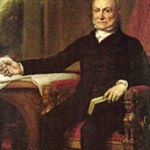At the beginning of the 1800s, during and after the War of 1812, the most powerful political party, and the one that had been in control since 1800, the Democratic-Republicans had begun to divide. From this one party came the Nation Republican Party and the Democratic Party. The National Republican Party had inherited a few ideas from the opposing party, the Federalists. Once of these ideas was for the idea of a National Bank. Alexander Hamilton, a Federalist, was one activist for the First National Bank of the United States, but the Second Bank of the United States had become a symbol of the National Republican Party once it was chartered in 1816. The Second Bank of America was brought in order to serve many functions that would attempt the whole country economically.
The Second Bank regulated the money supply and currency as an entire nation, with all taxes being payable to the federal government through the Bank of the United States. The National Bank would prevent inflation by restricting the power of state and local banks to print bank notes, because the National Bank could require the smaller banks to repay to the National Bank. The National Bank also aided the Federal government in funding large-scale national projects, because gathering from a bank that was run nationally would prove to be easier than attempting to retrieve funds from local and state banks that may be less willing to give it up. The National Bank also provided the ability for investment to both public and private corporations by supporting enterprises. The National Bank had vast amounts of reserves it gathered by way of taxes, and the bank could loan these out to private enterprises to promote investments.
The idea of the National Bank was first conceived and put into action by Alexander Hamilton, the first Secretary of Treasury and firm opponent of Thomas Jefferson, a Democratic-Republican. The original idea of a national bank was opposed by Thomas Jefferson, and when members of the Democratic-Republican Party including James Madison, helped to charter the Second Bank of the United States it was seen as an outrage and treason to the party. The Second Bank was chartered to help regulate a national currency, and it was blamed, especially by anti-Bank Democratic Republicans, for creating the economic Panic of 1819. When elected in 1828, Democratic-Republican President Andrew Jackson wanted to do all in his power to dismantle the National Bank.
Jackson was hindered by the chartering of the national bank. The bank’s charter had the life of the bank being 20 years, which would go through the two terms Jackson would serve as President. In his first term he did not have as much political power as he would have liked, and as the charter was not even near expiring there was little he could do to oppose it. In 1832, right in the middle of Jackson’s presidency, the president of the bank, Nicholas Biddle, requested Congress to allow for a re-chartering of the Bank. Henry Clay, a National Republican, was in favor for the Bank’s charter to be renewed. Jackson could not veto it because of the strong power that the charter had in Congress that would override the veto, but as a Democratic-Republican it was against his political views to sign it.
He refused to sign it and wanted to take his chances by vetoing the petition to re-charter the Bank. Jackson portrayed the supporters of the National Bank as men with investments and wrapped in money, something that had many American citizens on his side against the re-chartering. Clay foresaw financial repercussions if the veto was allowed to destroy the Bank. Once the veto was allowed to pass by Congress, Henry Clay believed the outrage of the American citizens would allow him to easily win the Election of 1832 over Jackson. Instead, the veto of the Bank of the United States helped Jackson to win a second term as President during 1832, though the problems with the National Bank were far from over.
Andrew Jackson wanted to remove the deposits the Federal government had made in the National Bank while the Bank was in its last half-decade of its charter. The last four years of Jackson’s presidency was also the last years of the Second National Bank’s first 20-year charter. Two Secretaries of Treasury under Andrew Jackson, Louis McLane and William Duane, refused to help Jackson to remove the deposits, and finally, in 1833, Jackson recruited Roger Taney as Secretary of Treasury to take out the deposits. The deposits were then moved from the United States National Bank into seven state banks which were deemed “pet banks.” Jackson would then give surplus revenue of the government out to these states. With the dismantling of the National Bank, Jackson also wanted to do away with the national, unifying currency. He made more use of his own “Spoils system” by allocating Taney the Chief Justice of the Supreme Court after John Marshall died.
Source:
Arthur Schlesinger’s “The Age of Jackson”


